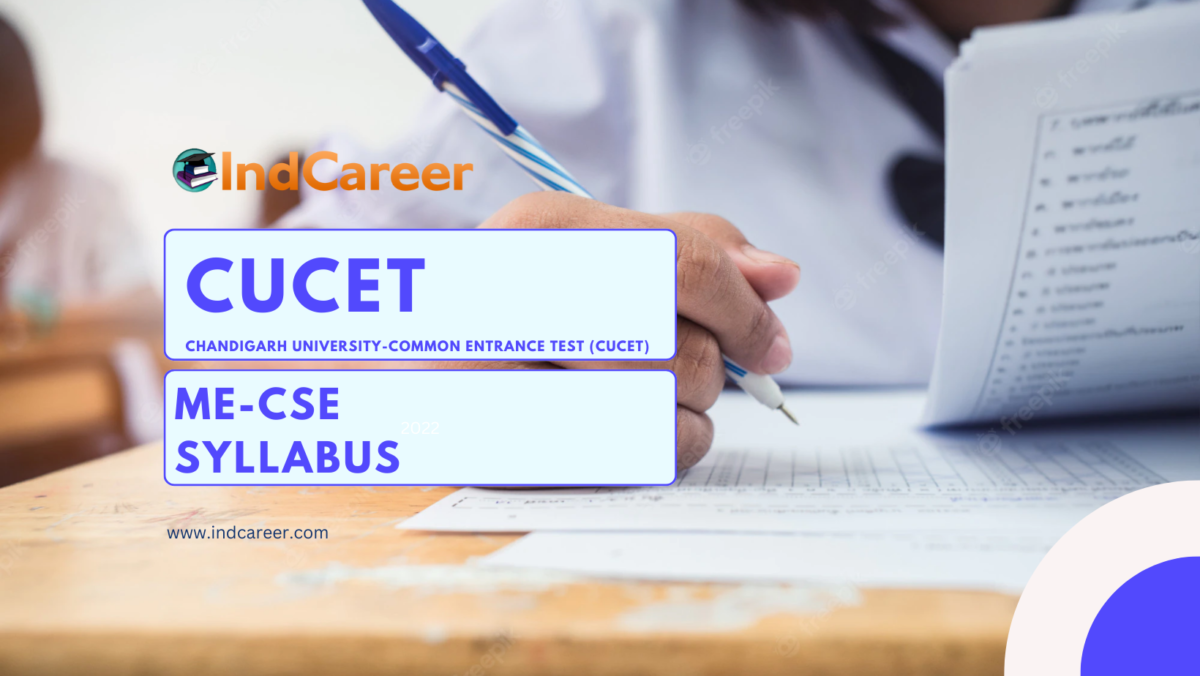Contents
- 1 CUCET ME-CSE Syllabus
- 1.1 SUBJECT -1: DIGITAL LOGIC AND CIRCUITS
- 1.2 SUBJECT -2: COMPUTER ORGANIZATION AND ARCHITECTURE
- 1.3 SUBJECT -3: DATA STRUCTURES & PROGRAMMING
- 1.4 SUBJECT -4: ALGORITHMS
- 1.5 SUBJECT -6: COMPILER DESIGN
- 1.6 SUBJECT -7: OPERATING SYSTEM
- 1.7 SUBJECT -8: DATABASE MANAGEMENT SYSTEMS
- 1.8 SUBJECT -9: COMPUTER NETWORKS
- 1.9 SUBJECT -10: ENGINEERING MATHEMATICS
Chandigarh University has decided to conduct an entrance cum scholarship test named as Chandigarh University Common Entrance Test (CUCET) for admission to various programs so as to provide an opportunity to bright and inquisitive young minds from across the country to study in most challenging and diverse academic environment.
CUCET Syllabus has been released by the authorities of Chandigarh University. Candidates can check the syllabus of CUCET 2023 to know the subjects, units and topics that have to be studied for the upcoming entrance examination. The subject-wise CUCET syllabus will allow the candidates to become familiar with the topics that they have to prepare to excel in the examination. Read to know more about CUCET Syllabus 2023.
CUCET ME-CSE Syllabus
SUBJECT -1: DIGITAL LOGIC AND CIRCUITS
Boolean Algebra, Logic Gates, Number Representation , Minimization , Multiplexers, Decoders, Encoders, Shift Registers, Minimization. Number representations and computer arithmetic (fixed and floating point), Combinational and sequential circuits.
SUBJECT -2: COMPUTER ORGANIZATION AND ARCHITECTURE
Machine instructions and addressing modes, ALU, data-path and control unit, Instruction pipelining, pipeline hazards.
Memory hierarchy: cache, main memory and secondary storage; I/O interface (interrupt and DMA mode), Associative Memory
SUBJECT -3: DATA STRUCTURES & PROGRAMMING
Programming in C/C++ -Procedural Approach/Object Oriented Programming Approach. Concept of Classes, Objects, Inheritance, Polymorphism, File handling, Constructors .
Data structures : Arrays, Link lists, Types of Link Lists, Recursion, Stacks , Queues, Trees: Binary tree, Binary search tree, AVL, Heaps, Red black trees, Graphs , Pointers , Array of Pointers
SUBJECT -4: ALGORITHMS
Asymptotic Notations: Best Case , Average Case & Worst Case, Space Complexity & Time Complexity. Problem Solving Approaches : Divide & conquer ,Greedy, Dynamic. Graph Traversals: DFS, BFS, Minimum Spanning Tree : Prims , Shortest Path Algorithms: Kruskal, Dijkstra, Floyd Warshal. Searching, Hashing & Sorting : Insertion Sort, Selection Sort , Quick Sort, Merge Sort, Counting Sort, Heap Sort, Pattern Matching Algorithms : KMP, Naïve , Rabin Karp, Suffix trees
SUBJECT -5: THEORY OF COMPUTATION
Regular expressions, Finite automata. Context-free grammars and push-down automata.
Regular and context-free languages, pumping lemma. Turing machines and undecidability
SUBJECT -6: COMPILER DESIGN
Lexical analysis, parsing, syntax-directed translation. Runtime environments. Intermediate code generation. Local optimization, Data flow analyses: constant propagation, liveness analysis, common subexpression elimination.
SUBJECT -7: OPERATING SYSTEM
Need for Operating System, Functions, Multi programming System, Multi-tasking system, Interrupts, Process , Thread , Process State, process Scheduling: Preemptive , Non-Preemptive, Inter-process Communication : Semaphores, CPU Scheduling , I/O Scheduling, Deadlock: Bankers Algorithm, Disk Scheduling, RAID structure, Memory Management , Virtual Memory
SUBJECT -8: DATABASE MANAGEMENT SYSTEMS
ER‐model. Relational model: relational algebra: SELECT and PROJECT; Relational Algebra Operations from Set Theory; Binary Relational Operations: JOIN and DIVISION; Additional Relational Operations; the Tuple Relational Calculus; the Domain Relational Calculus, tuple calculus, SQL. Integrity constraints, normal forms. Transactions and concurrency control. File organization, indexing (e.g., B and B+ trees), Database Recovery Techniques
SUBJECT -9: COMPUTER NETWORKS
OSI and TCP Layer Model, Simplex, half duplex, Full-duplex, Circuit Switching and Packet Switching, Functions of OSI Model layers , Data Link Layer : Framing , Error Detection , IP addressing , Subnet Mask, IPv4, Classless Addressing, Network Address Translation , Routing Algorithms : Dijkstra, Flooding, IP Protocols : ARP,DHCP, RARP, Transport Layer, sockets , Connection less and Connection Oriented Service: TCP, UDP, , Application Layer Protocols: SMPT, HTTP, FTP etc.
SUBJECT -10: ENGINEERING MATHEMATICS
Discrete Mathematics: Propositional and first order logic. Monoids, Groups. Graphs: connectivity, matching, coloring. Sets, relations, functions, partial orders and lattices. Combinatorics: counting, recurrence relations, generating functions. Linear Algebra: Matrices, determinants, system of linear equations, eigenvalues and eigenvectors, LU decomposition. Calculus: Limits, continuity and differentiability. Maxima and minima. Mean value theorem. Integration. Probability and Statistics: Random variables. Uniform, normal, exponential, Poisson and binomial distributions. Mean, median, mode and standard deviation. Conditional probability and Bayes theorem. Computer Science and Information Technology
